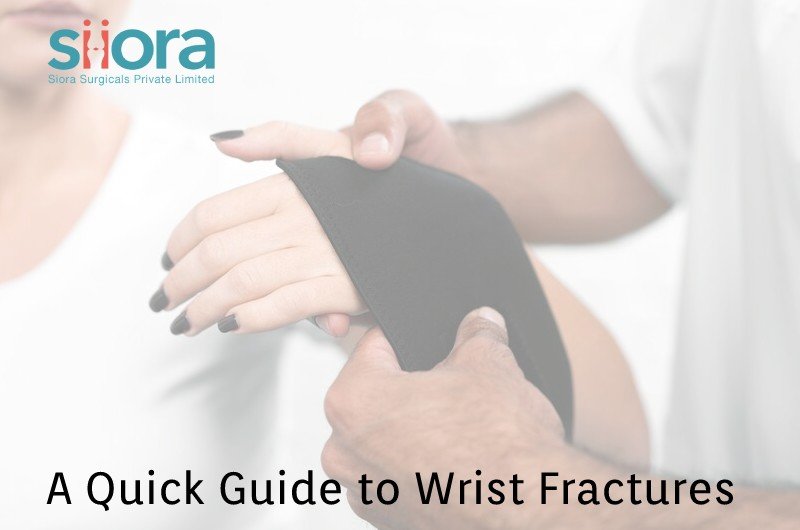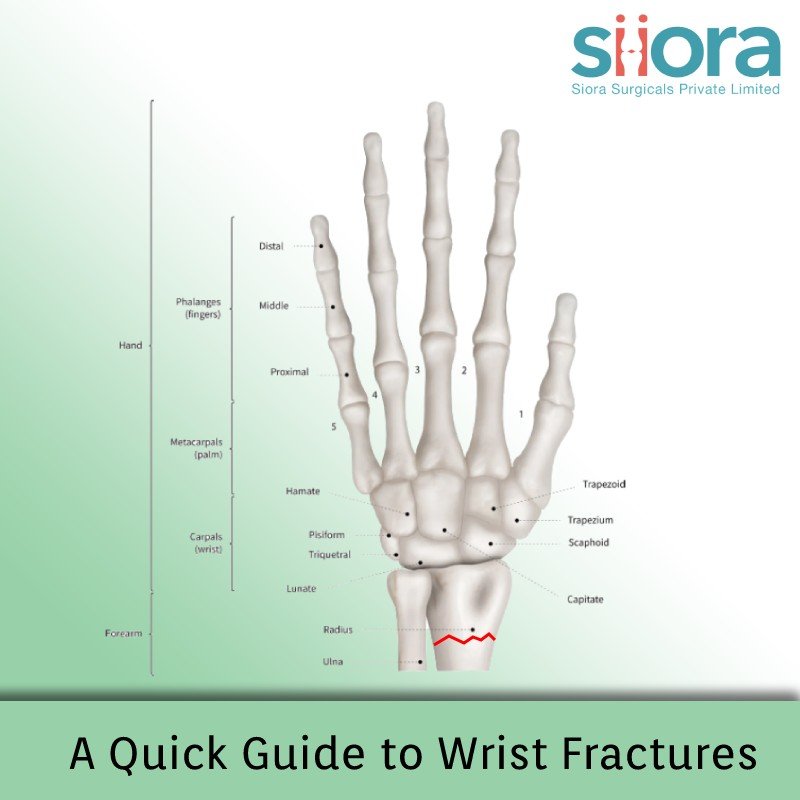A wrist fracture is a condition in which there is a broken bone in our wrist. In this condition, any of the bones in our wrists could break. When a bone in our wrist breaks, it limits the activities that it performs and directly affects the person’s routine life. In this blog, we will see wrist fractures, their types, and treatment.
What is a Wrist Fracture?
Our wrist has several small joints which provide it the ability to move in different directions. To be precise, there are 8 small bones known as carpals in our wrist along with two forearm bones i.e., radius and ulna. All these bones connect to form a wrist joint and connective tissues like tendons & ligaments provide support.
Now, if we talk about a fracture in our wrist, then it could be a break in any of these bones. Sometimes, a break may occur in more than one bone.
Wrist fractures are common, and they often occur when someone tries to catch himself/herself during a fall. Here, any of the carpals or forearm bones can break, and the severity of the fracture will depend upon the cause. A broken wrist will make it difficult/painful for the person to type, write, hold objects, or do anything involving that wrist. In severe cases, the orthopedic specialist will immobilize the wrist for months.
What Are the Causes of Wrist Fractures?
Wrist fractures commonly occur because of traumatic injuries that may include falling on your hand, sports injuries, and automobile accidents. Let us see the causes in detail:
Falls
One of the commonest causes of wrist fractures is falling on an outstretched hand. This occurs because the body weight puts undue stress on the wrist joint resulting in a break in the wrist.
Sports Injuries
Contact sports are the cause of many types of fractures and a wrist fracture is one of those. Athletes who play contact sports are at high risk of falling on an outstretched hand. Some of the sports that make players prone to developing a wrist fracture include in-line skating, snowboarding, volleyball, rugby, horse riding, and hockey.
Automobile Accidents
Car crashes and two-wheeler accidents often cause fractures along with other injuries. And when it comes to wrist fractures, then automobile accidents are among the prime causes. However, the severity of the fractures that occur because of car/bike crashes is high, hence, surgical intervention is required for the treatment.

What Are the Types of Wrist Fractures?
Wrist fractures can be classified based on the location and severity of the break. Here are some of the types of wrist fractures that are reported:
Distal Radius Fracture
The distal radius is one of the two bones in our forearm. A break in the radius near the wrist is a distal radius fracture. It is one of the commonest wrist fractures that occur when someone falls on an outstretched hand. Distal radius can also break because of a car accident or skiing accident. Distal radius fractures can be of two types:
Colles Fracture
This is a type of wrist fracture in which the radius is bent backward after breaking. Dorsal angulation is seen in the case of Colles fractures.
Smith Fracture
Smith fracture is characterized by the volar displacement of the fractured fragment of the distal radius. This fracture is also called a reverse Colles fracture.
Radial Fracture
A radial fracture is a break at the tip of the radius. This fracture is also called a chauffeur fracture or backfire fracture.
Distal Ulna Fracture
Distal ulna fractures are those in which the break in the ulna occurs on the side of the wrist. These fractures often occur in combination with distal radius fractures. They are also called ulnar styloid fractures.
Hairline Wrist Fracture
When a small crack develops in one of the bones in the wrist over time, the condition is called a stress fracture. These fractures often occur when repeated stress results in a break in a wrist bone.
Scaphoid Fracture
A scaphoid is a bone that is present near the thumb in our wrist. A break here is known as a scaphoid fracture. Scaphoid fractures can be noticed when you experience pain along the side of the thumb while holding or grabbing an object.
Buckle Wrist Fracture
This is a type of incomplete fracture that often affects kids. Also known as a torus or impacted fracture, they occur when sudden pressure is applied to the wrist. These fractures may take around a month to heal.
Barton’s Wrist Fracture
This is a rare type of wrist fracture as it occurs when someone falls on a bent wrist. These fractures accompany a broken bone and a dislocated bone.
What Are the Symptoms of a Wrist Fracture?
The symptoms of a wrist fracture may vary depending on the type of break and its severity. Some of the common signs and symptoms associated with the fracture include:
- Severe pain or discomfort in the wrist
- Tenderness to touch
- Numbness or tingling in the fingers
- Bruising and swelling on the injured wrist
- Discoloration of fingers may occur
- Deformity on the wrist
- Difficulty in holding or grabbing the objects
- Reduced range of motion of the wrist
- In some cases, the person may become unable to use the injured wrist
What is the Diagnosis of a Wrist Fracture?
Both physical examination and imaging tests are required for the correct diagnosis of a wrist fracture. At first, the orthopedic specialist will perform a physical examination of the wrist. Here, the healthcare service provider will look for the deformity in the wrist along with other signs like swelling, bruising, and tenderness. With this, the patient will also be asked to move the wrist in different directions to check the range of motion. However, this examination will make it easier for the orthopedic specialist to assess the condition. Certain imaging tests will also be ordered to confirm the fracture, its type, and severity:
- X-ray
- CT Scan
- MRI
What is the Treatment for a Wrist Fracture?
The severity of the wrist fracture that the imaging test reports give will decide the feasible treatment of the fracture. However, fractures in which minimal to no displacement of the bone are there can be managed without surgery. While on the other hand, severe fractures often require surgical intervention.
The most important part of the treatment of wrist fractures is reduction. However, if the reduction is not done properly, there will be gaps between fractured bone fragments. Besides this, the risk of overlapping of the fragments is also there. The type of reduction required will be decided by the orthopedic specialist depending on the severity. Two processes by which a fracture can be reduced include open reduction and closed reduction.
Here are some of the treatment methods for a wrist fracture:
Immobilization
A wrist fracture in which the broken bones are aligned in their true anatomy needs to be immobilized. This will ensure proper healing of the fracture and prevent making it worse. Immobilization can be achieved by splinting or the application of a cast. This may be the only treatment that most fractures in the wrist require.
Immobilization may also be necessary after surgical treatment.
Medication
Medicines are always prescribed irrespective of the type of treatment the patient is getting. Medicines aim at reducing pain and swelling. Orthopedic specialists often prescribe non-steroidal anti-inflammatory drugs to curb pain and inflammation.
Physical Therapy
Physiotherapy helps regain the strength and range of motion of the injured wrist once the splint or a cast is removed. It must be carried out under the guidance of a skilled physiotherapist as doing exercises wrongly could do more harm than good.
Surgery
Severe fractures in the wrist often need surgery for treatment. The surgery involves the use of orthopedic implant plates, bone screws, rods, pins, or wires. In some cases, a bone graft is also required to promote the healing of the fracture. Open reduction and internal fixation is the common surgical procedure that surgeons use for fixing a fracture. If ORIF is not feasible, the orthopedic specialist will recommend external fixation.
After treatment, the orthopedic surgeon will monitor the healing progress with periodic x-ray examinations. If bone fragments shift even after immobilization (in the case of non-surgical treatment), the healthcare service provider may recommend surgery. While on the other hand, in some cases, repeat surgery is required if the bones move out of their anatomy or the implant fails.
Siora Surgicals Pvt. Ltd. is a renowned orthopedic implant manufacturer in India with over 30 years of experience in the industry. The company manufactures a CE-certified range of hand implants and other orthopedic devices. All the implants Siora manufacture are tested against strict quality parameters before being approved fit for use. The company is also a trustworthy OEM/contract manufacturing service provider around the globe.







